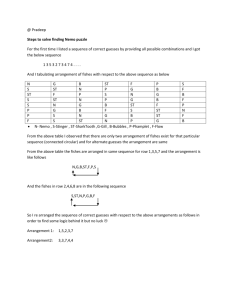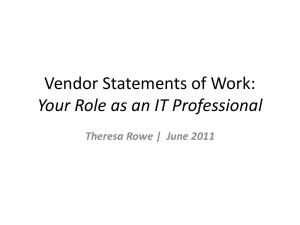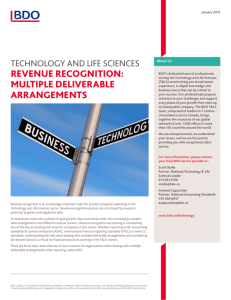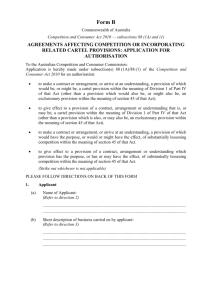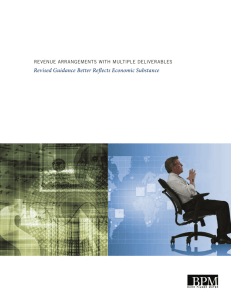Revenue Recognition - Multiple-Element Arrangements ASC 605 25
advertisement
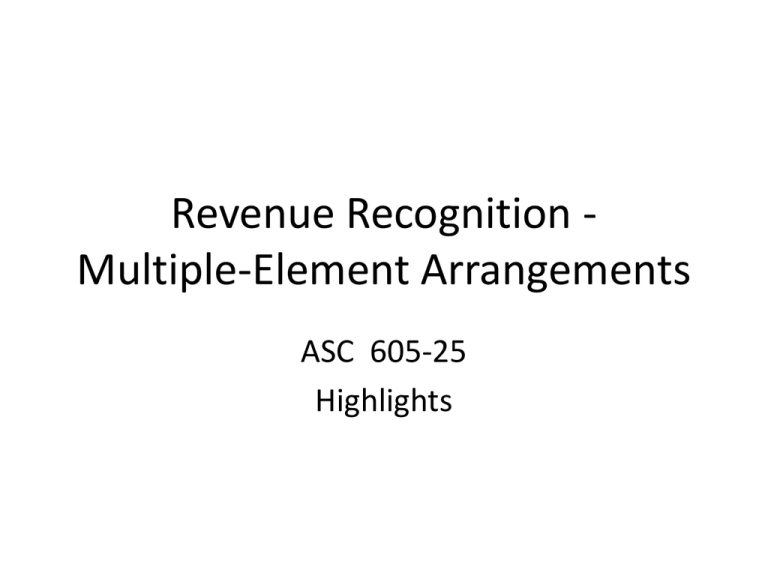
Revenue Recognition Multiple-Element Arrangements ASC 605-25 Highlights Overview • This topic addresses accounting by a vendor for arrangements under which there are multiple revenuegenerating activities, including – how to determine whether an arrangement involving multiple deliverables contains more than one unit of accounting and – how arrangement consideration should be measured and allocated to the separate units of accounting. • Examples: – May be multiple products, services, or rights – May involve performance at different times or different periods of time. – May include initial installation, initiation, or activation services in the form of a fixed fee or a fixed fee coupled with a continuing payment stream. – Fees for continuing performance may be fixed, variable based on future performance, or a combination. Scope • Applies to all entities • Applies to – all deliverables • products, services, or rights to use assets – within contractually binding arrangements • written, oral or implied – in all industries – under which a vendor will perform multiple revenue-generating activities. Does NOT apply to: • Arrangements that include vendor offers to a customer for – Free or discounted products or services delivered at a future date OR rebate or refund • if the customer completes a specified cumulative level of revenue transactions or remains a customer for a specified length of time. • Arrangements involving award credits by loyalty program operators • Payments relating to R&D deliverables that are accounted for under the milestone method of revenue recognition (605-28) Interaction with other topics • If another topic addresses both separate units of accounting and allocation of consideration, – apply that topic. • If another topic addresses separate units of accounting but not allocation of consideration, – allocate consideration per the relative selling price of the deliverables. • If another topic addresses neither separate unit of accounting or allocation of consideration, – follow this subtopic. • This subtopic does not address when the criteria for revenue recognition are met • or provide the appropriate revenue recognition convention for a unit of accounting. Recognition • Again, this subtopic provides guidance for determining: – units of accounting within a multiple deliverable arrangement and – measurement and allocation of consideration among the separate units of accounting. • Revenue arrangement with multiple deliverables shall be divided into separate units of accounting if certain criteria are met, • and arrangement consideration shall be allocated among the separate units of accounting based on relative selling prices. • Applicable revenue recognition criteria is considered separately for separate units of accounting. • Units of accounting: – Separate contracts with the same entity or related parties that are entered into at or near the same time are presumed to have been negotiated as a package and are considered a single arrangement in determining the units of accounting – Evaluation of units of accounting is done at the inception of the arrangement • Delivered item(s) are considered a separate unit of accounting if both of the following criteria are met: – Delivered item has value to the customer on a standalone basis: • if they are sold separately by any vendor • or if the customer could resell the delivered items on a standalone basis – Does not require the existence of an observable market – If the arrangement includes a right of return for the delivered item, delivery or performance of the undelivered item is considered probable and substantially in the control of the vendor. Initial Measurement • Consideration is allocated at the inception of the arrangement to all deliverables on the basis of their relative selling price, – unless required under another topic to be recorded at fair value and marked to market each reporting period thereafter. • Selling price is determined using: – vendor-specific objective evidence of selling price if possible (preferred) • limited to either the price charged for a deliverable when it is sold separately or if not sold separately, the prics established by management having relevant authority – or third party evidence of selling price • Price for interchangeable products or services in standalone sales to similarly situated customers – or worst case – use the best estimate of selling price. • Consider market conditions as well as entity-specific factors • The amount allocable to a delivered item is limited to the amount that is not contingent upon delivery of additional items or meeting other performance conditions. • The revenue per period is limited to the measurement assuming cancellation will not occur. – An asset for the excess of revenue recognized over the amount of cash received shall not exceed all amounts to which the vendor is legally entitled, including cancellation fees. • Consider whether the vendor intends to enforce cancellation fees in determining the amount of any asset. • Contractually stated prices for individual products or services in a multiple deliverable arrangement shall not be presumed to be representative of vendor-specific objective evidence, third-party evidence or a vendor’s best estimate of selling price.
